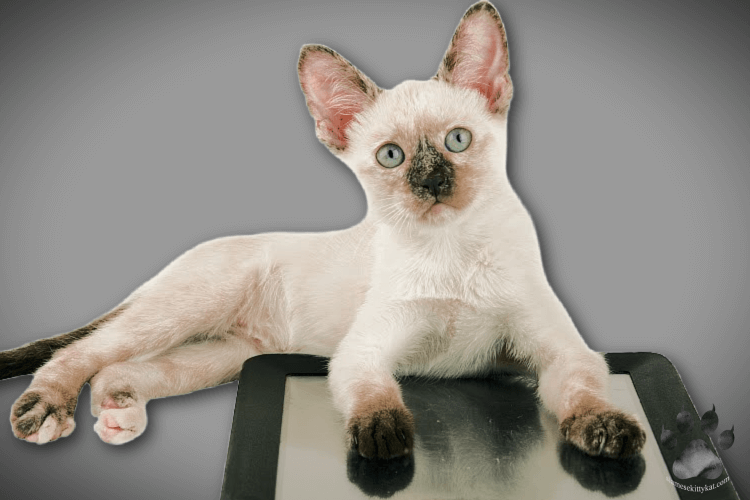Siamese kittens go through lots of physical changes before they turn into small adult cats. That’s why it’s very important to know their age and meet their needs during each stage of development.
You can easily determine your Siamese kitten’s age by:
Read more as I guide you to your kitten’s development throughout the first month of his life, so you can keep track of how much he’s growing.
How Can I Estimate My Kitten’s Age?
You can estimate your kitten’s age in a few different ways.
When I was younger, my family had two cats. One was an adult, and the other was a kitten. We always used to joke that the kitten never stopped moving. She was always playing, chasing her tail or jumping around. Compared to our adult cat, she seemed like a ball of energy. As it turns out, that playful kitten was actually quite young.
Kittens are typically more energetic and playful than adult cats, so if your kitten seems exceptionally playful, they’re probably on the younger side.
Older cats may also have more wrinkles and lumps on their skin.
All of these are just estimates, though. The best way to know for sure is to take them to the vet for a checkup.
How Fast Do Siamese Kittens Grow?
Siamese kittens are born very small and grow quickly during their first few weeks of life.
- By the end of their first week, they will have more than doubled in size.
- During their second week, Siamese kittens will continue to grow rapidly. They will also start to develop some of their distinctive Siamese features, including their blue eyes and darker points.
- By the end of their third week, Siamese kittens will be starting to look like miniature versions of adult cats. They will be fully furred, and their eyes will be fully open.
- During their fourth week, Siamese kittens will reach half their adult size. Their legs will lengthen, and their heads will widen, giving them a distinctive wedge shape. In addition, Siamese kittens’ ears will stand up on top of their head for the first time.
- During their fifth week, Siamese kittens gain considerable weight as they put on muscle mass to prepare for adulthood. Their tails lengthen at this time as well. The color of their coat begins to darken around this age as well.
- During their sixth week, Siamese kittens become fully grown adults! Many female Siamese cats come into heat between six and eight months old, while males may not enter puberty until they are one year old or older! Siamese kittens can grow to be anywhere from 10 to 16 pounds when they’re fully grown!
- After two years, the average Siamese cat is about 16 pounds, but individual cats can weigh anywhere from 8 to 12 pounds.
What are the Stages of a Kitten’s Development?

Kittens develop quickly and go through several stages of growth in their first few months of life.
Five days
A five-day kitten has only recently emerged from the safety of the womb and is just beginning to understand what the world around him looks like. Kittens are born deaf and blind, and this is most definitely by design to protect them from predators.
Even though his eyes are still closed, he can sense that a lot is happening outside his small, dark habitat. And even though it seems like things are rough for him at this point in time, he does have some comforts, knowing that his mother is close by and ready to provide for him should anything go wrong.
Kittens are very dependent on their mothers after being born. They need to follow their mother’s scent so they do not get lost and can find nourishment whenever they need it. During the first week of their lives, kittens sleep and feed constantly.
Two weeks
The eyes of newborn kittens open at about two weeks. They tend to be blue, but that color isn’t permanent since the kitten’s eyes will naturally change as he matures. At this stage, the smell is the kitten’s strongest sense, and they may become uncomfortable or even irritated if they notice unfamiliar scents in their environment!
Four weeks
The kitten is growing fast! At four weeks old, they are becoming capable of walking and balancing with their tail erect like a balancing pole. Their sight and hearing have also improved, and they may react to noises with curiosity. Some baby teeth have come through, and the digestive system can begin to handle solid food. The mother cat will start weaning her offspring at this point.
Kittens at four weeks old are getting used to solid foods and eating by themselves. You will need to place their dishes on a waterproof surface such as newspaper or in a shallow tray because early weaning tends to mean messy meals.
As time goes on, the kitty will learn how to eat and properly use his mouth, so his food won’t be all over the place – but it can take him up until 8 weeks old to fully adjust.
Eight weeks
The weaning phase is usually over after about eight weeks. The kittens also rapidly grow coordination, muscle strength, locomotion, and balance.
At this point, the kittens will be acting much like their adult counterparts in a lot of ways. For example, they may begin to groom themselves and even try to “hunt” when playing.
Add stimulating toys to the environment so kittens master their dexterity as young as possible.
Ten weeks
After ten weeks, kittens are almost ready to leave home. They’re old enough now to run around and explore the world unsupervised. They’re also big enough to begin climbing and jumping on things, so make sure you watch them closely. Kittens must get their vaccinations during this stage of their growth!
It can be tough to track where your kitten is at in their development. While kittens grow rapidly at first, their growth slows significantly as they mature into adults. Kittens continue to grow and develop into adulthood, typically reaching full size by around one year of age.
Kittens typically weigh between 2 and 6 pounds as adult cats and measure around 15-17 inches from head to the body. In general, kittens reach maturity at around five years of age. Your kitten is expected to live an average of 12 years, though there is a chance that it could live longer.
At What Age do Siamese Kittens Get Their Points?

Siamese kittens are born without their points, which are the darker markings on their faces, ears, legs, and tails. These points usually start to develop around four weeks of age, and they continue to darken as the kitten grows older. Its points should be fully developed when a Siamese kitten is twelve weeks old.
At What Age do Kittens Start to Purr?
Kittens start to purr at around 3 weeks of age. This is when they start to socialize with their littermates and their mother. Purring is a way for them to communicate their contentment and well-being. It’s also a way for them to bond with their mother and littermates.
Researchers have found that the purring sound happens when a cat’s brain sends signals to its throat muscles, causing the larynx to vibrate. These vibrations happen with each breath and make the purring sound continuous.
Some cats’ purrs are so loud that the cats across the room can hear them. But others purr so quietly that you know your cat is purring only by feeling vibrations on your skin or clothes.
It has been found out through many studies of animal behavior that most cats also tend to purr when frightened or nervous.
At What Age do Kittens Start Hissing?
Kittens start to hiss when they are around 3 to 4 months old. This is when they start to become more independent and assert themselves more. Hissing is a way for them to communicate that they are feeling threatened or uncomfortable. It is also a way to show their displeasure or to warn off potential threats. Kittens learn to hiss from their mothers, who use it as a way to protect their young.
If you have a kitten that is hissing, it is important to try to figure out what is causing the stress. Often, it is something as simple as not having enough toys or being too hot or cold. Once you identify the source of the stress, you can take steps to alleviate it and help your kitten feel more comfortable.
At this point in time, you have successfully made it through the stages of a Siamese kitten’s development. You may be wondering if they will ever stop growing and developing? Most likely not! They are definitely going to keep on making new discoveries as they grow older.
It is clear that the first weeks are critical to a kitten’s development.
As your kitten grows, they will also become more independent, so you might need to start training them soon! Don’t worry, though. Starting early will make raising a confident Siamese kitten much easier for both of you!
Have any questions about how to care for a Siamese kitten? Read some of our articles on how to raise a happy and healthy Siamese cat!
We gathered all the health tips tailored toward maintaining your Siamese cat’s optimal well-being. Check it out here: Siamese Cat Health: A Complete Guide
